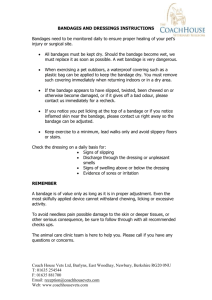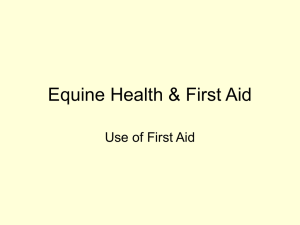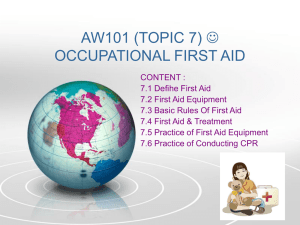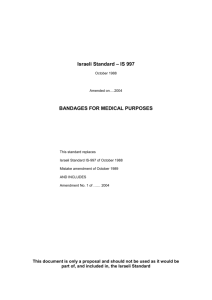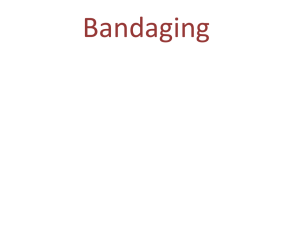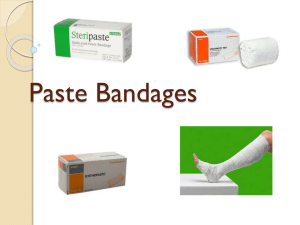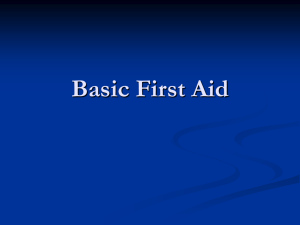Dressings and Bandages
advertisement
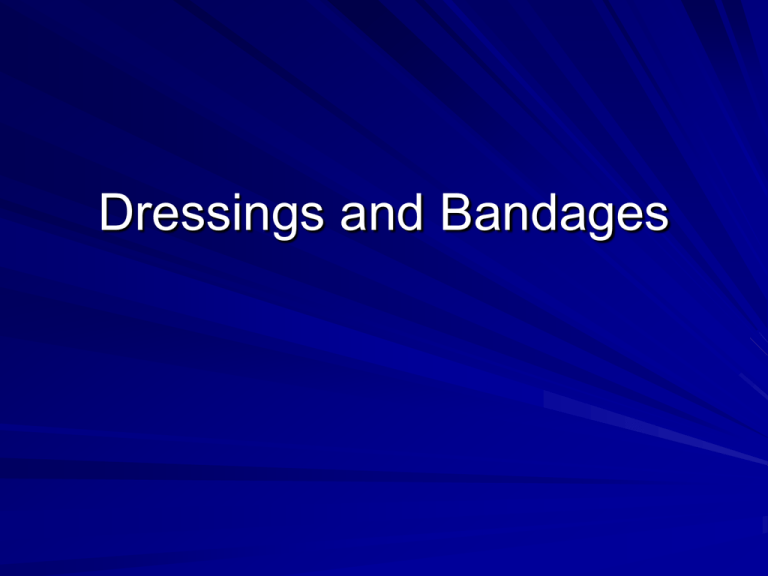
Dressings and Bandages Dressings Dressings Sterile covering placed over wound or injured part Used to control bleeding, absorb blood and secretions, prevent infection and ease pain Dressings are held in place with tape or a bandage Dressings Types of materials – Gauze pads in a variety of sizes – Compresses with thick absorbent material – Avoid fluff cotton because loose cotton fibers may contaminate the wound – Handkerchief or pillowcase may be used in emergency Bandages Bandages Materials used to hold dressings in place, to secure splints and to support and protect body parts Apply snugly enough to control bleeding and prevent movement of dressing, but not so tightly that they interfere with circulation Bandages Types of materials – Roller gauze bandages Come in variety of widths Common ones are 1-, 2-, and 3-inch widths Used to hold dressings in place on almost any part of the body Bandages – Triangular bandages Used to secure dressings on head/scalp or as a sling At times used as covering for large body part such as hand, foot or shoulder – Elastic bandages Readily conform or mold to injured part Can be hazardous if applied too tightly or stretched during application because they can cut off or constrict circulation Used to provide support or stimulate circulation Applying Dressings Applying dressings Obtain correct size: should be large enough to extend at least 1 inch beyond edges of wound Prevent infection by avoiding contamination of dressing Open package taking care not to touch or handle sterile dressing with your fingers Applying Dressings Pick up dressing with pinching action so you handle only one side or outside of dressing Place dressing on wound with untouched side against wound Secure dressing in place with tape or bandage wrap Methods of Wrapping Bandages Methods of wrapping bandages Several methods are used Method used depends on body part involved Methods of Wrapping Bandages Circular bandage – Frequently used to hold dressings on body parts such as arms, legs, chest or abdomen – Triangular bandage folded down to form strip of bandage or cravat – Strips of cloth or gauze bandage can also be used – Example – pressure bandage Methods of Wrapping Bandages Spiral wrap bandage – Used to hold dressings in place on arm or leg or used to provide support to a limb – Spiral wrap is started at bottom of limb and moves up in direction of blood flow to the heart – Spiral motion is used to encircle the limb and the bandage is overlapped about one-half its width on each turn – At top of limb or stopping point, end with one or two circular wraps around limb – Secure end with tape, pins or clips Methods of Wrapping Bandages Figure eight wrap – Used to hold bandages or provide support to joints such as ankle or wrist – Elastic bandage is used if support is provided – Anchor bandage on instep of foot – Make one or two circular turns around instep of foot Methods of Wrapping Bandages – Form a figure eight Carry bandage up over foot in diagonal direction Wrap bandage around back of ankle Come down over top of the foot Circle under the instep – Repeat figure eight pattern while moving downward and backward toward heel with each successive turn – Overlap previous turn by one-half to two-thirds width of bandage – End by circling ankle with one or two circular turns – Secure in place with tape, clips or pins Methods of Wrapping Bandages Recurrent wrap to finger – Used to hold dressing or splint on finger – Fold bandage backward and forward over finger three to four times to form a recurrent wrap – Start at bottom of finger and use spiral wrap up and down the finger to hold recurrent wraps in position – Use a figure eight around the wrist to hold bandage in place – End with one or two circular wraps around the wrist – Tie, tape or pin bandage at the wrist Checkpoints for Circulation Checkpoints for circulation Important to check circulation after bandage applied to make sure bandage is not too tight Signs of poor or impaired circulation – – – – – Swelling or edema Pale or cyanotic color Coldness to touch Numbness or tingling Poor or slow return to pink color after nailbeds are blanched Loosen bandages immediately if any signs of impaired circulation are noted
